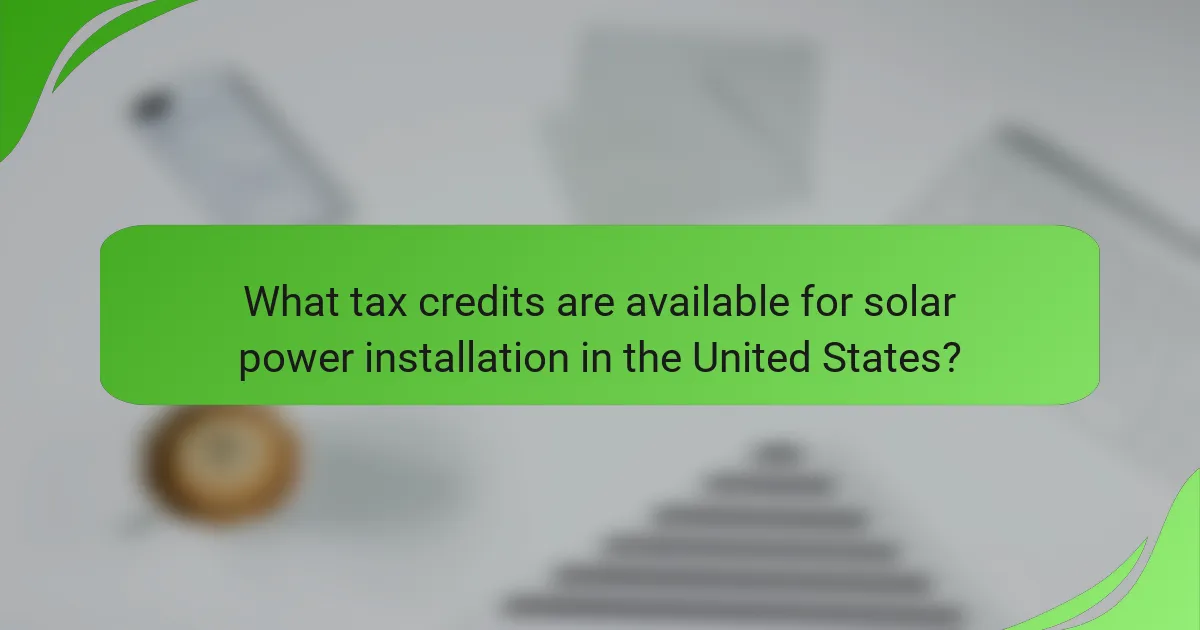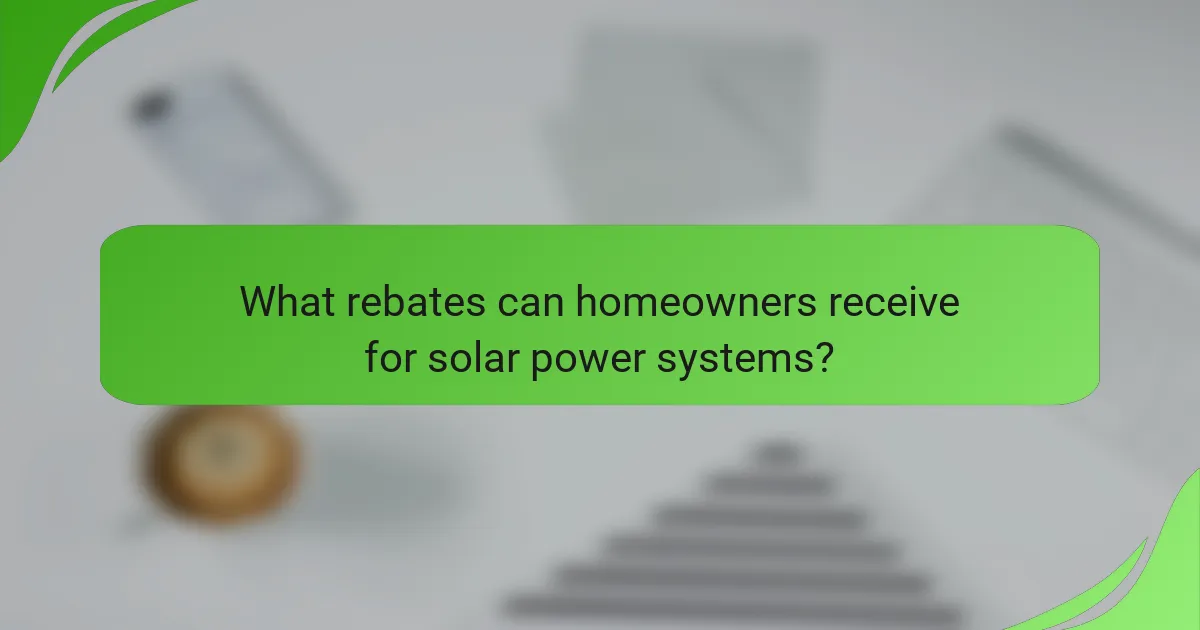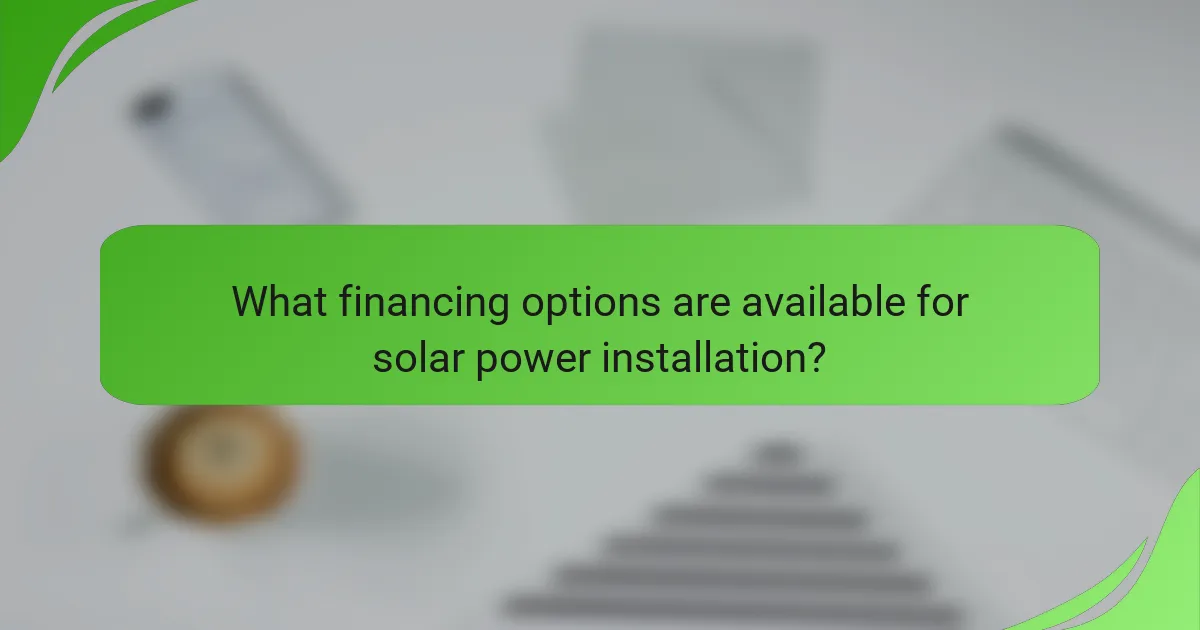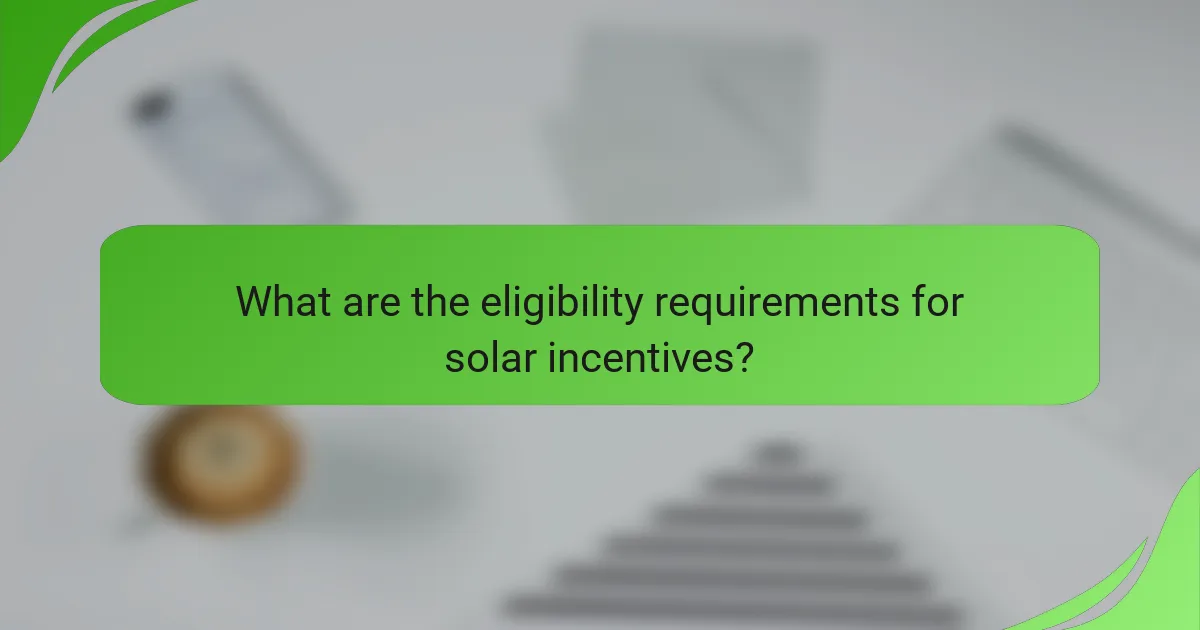Incentives for solar power installation play a crucial role in making renewable energy more accessible and affordable. In the United States, homeowners can take advantage of tax credits, rebates, and various financing options that significantly reduce the initial costs associated with solar energy systems. From the Federal Investment Tax Credit to local utility rebates and flexible financing arrangements, these incentives help facilitate the transition to clean energy.

What tax credits are available for solar power installation in the United States?
In the United States, several tax credits are available to incentivize solar power installation, significantly reducing upfront costs. These include the Federal Investment Tax Credit (ITC), state-specific tax credits, and local government incentives that vary by region.
Federal Investment Tax Credit (ITC)
The Federal Investment Tax Credit (ITC) allows homeowners and businesses to deduct a significant percentage of the cost of installing solar energy systems from their federal taxes. As of 2023, this credit is set at 30% of the installation costs, which can lead to substantial savings.
To qualify for the ITC, the solar system must be installed on your property and be operational by the end of the tax year. It’s crucial to keep all receipts and documentation related to the installation to claim this credit effectively.
State-specific tax credits
Many states offer their own tax credits for solar power installation, which can further enhance savings. These credits often vary widely in amount and eligibility requirements, so it’s important to research the specific incentives available in your state.
For example, states like California and New York provide additional credits that can range from a few hundred to several thousand dollars. Check with your state’s energy office or tax authority for the most current information and application procedures.
Local government incentives
Local governments may offer additional incentives such as rebates, grants, or property tax exemptions for solar installations. These incentives can significantly reduce the overall cost of solar systems and encourage adoption at the community level.
For instance, some municipalities provide upfront rebates that can cover a portion of installation costs, while others may exempt solar installations from property tax assessments. Always consult your local government’s website or energy office to discover what incentives are available in your area.

What rebates can homeowners receive for solar power systems?
Homeowners can receive various rebates for solar power systems, which can significantly reduce installation costs. These rebates come from utility companies, state programs, and local municipalities, each offering different incentives and eligibility criteria.
Utility company rebates
Many utility companies provide rebates to homeowners who install solar power systems. These rebates typically aim to encourage renewable energy use and can range from a few hundred to several thousand dollars, depending on the size of the system and the utility’s policies.
To qualify, homeowners usually need to apply for the rebate before installation and ensure their system meets specific technical standards. It’s essential to check with your local utility provider for details on available programs and application processes.
State rebate programs
State governments often offer rebate programs to promote solar energy adoption. These programs vary widely by state, with some offering substantial cash rebates based on system size or performance. For instance, states like California and New York have robust programs that can cover a significant portion of installation costs.
Homeowners should research their state’s energy office or public utility commission website to find specific rebate amounts, eligibility requirements, and application procedures. Timing is crucial, as funding for these programs can be limited and may change annually.
Local municipality rebates
Local municipalities may also provide rebates or incentives for solar power installations. These can include direct cash rebates, tax credits, or even property tax exemptions for solar energy systems. The availability and amount of these incentives depend on local government policies.
Homeowners should contact their city or county government offices to inquire about any local solar incentives. It’s advisable to stay informed about any changes in local regulations that could affect available rebates or incentives.

What financing options are available for solar power installation?
Several financing options exist for solar power installation, allowing homeowners and businesses to adopt solar energy without significant upfront costs. These options include solar loans, leasing arrangements, and Power Purchase Agreements (PPAs), each with distinct features and benefits.
Solar loans
Solar loans allow homeowners to borrow money to purchase and install solar panels, typically with fixed interest rates and terms ranging from five to twenty years. This option enables owners to benefit from tax credits and rebates, ultimately reducing the overall cost of the system.
When considering a solar loan, evaluate the total interest paid over the loan’s life and ensure that monthly payments align with your budget. Many lenders offer specific solar financing products, so shop around for the best rates and terms.
Leasing options
Leasing options enable homeowners to install solar panels without purchasing them outright. Instead, they pay a monthly fee to a solar company that owns the system, often with little to no upfront cost. This arrangement typically includes maintenance and monitoring services.
While leasing can reduce immediate financial barriers, it may limit access to tax incentives and rebates that are available to outright owners. Be sure to read the lease terms carefully and understand the implications for energy savings and ownership at the end of the lease period.
Power Purchase Agreements (PPAs)
A Power Purchase Agreement (PPA) is a contract where a solar provider installs and maintains a solar system on your property, and you agree to buy the electricity generated at a predetermined rate. This option often requires no upfront payment and can provide savings on your electricity bill.
PPAs can be advantageous for those who want to avoid the responsibilities of ownership while still benefiting from solar energy. However, review the contract duration and terms carefully, as they can vary significantly and may affect long-term savings.

How do solar incentives vary by state?
Solar incentives differ significantly by state, impacting the overall cost and feasibility of solar power installation. These incentives can include tax credits, rebates, and financing options, which vary based on local regulations and available programs.
California solar incentives
California offers some of the most robust solar incentives in the United States. The state provides a significant federal tax credit, which can cover a substantial portion of installation costs, alongside state-specific rebates and performance-based incentives.
Additionally, California has a net metering policy that allows solar users to sell excess energy back to the grid, further enhancing the financial benefits. Homeowners can also explore financing options through programs like the California Solar Initiative, which helps reduce upfront costs.
New York solar incentives
New York provides various solar incentives that make installation more affordable. The state offers a federal tax credit and a state-level solar tax credit, which can significantly lower the overall investment required for solar systems.
Moreover, New York has a robust net metering program and the NY-Sun Initiative, which provides cash incentives for solar installations. Homeowners can also access low-interest loans and financing options to ease upfront costs, making solar power more accessible.
Texas solar incentives
Texas has a growing solar market with several incentives available, although they may not be as extensive as those in California or New York. The federal solar tax credit is available, allowing homeowners to deduct a portion of installation costs from their federal taxes.
In Texas, some local utilities offer rebates for solar installations, and there are financing options through programs like the Texas Property Assessed Clean Energy (PACE) program. However, net metering policies vary by utility, so it’s essential to check local regulations for potential benefits.

What are the eligibility requirements for solar incentives?
Eligibility for solar incentives typically depends on factors such as homeownership status, the size and type of the solar system, and the installation date. Understanding these criteria can help homeowners maximize their benefits from tax credits, rebates, and financing options.
Homeownership status
To qualify for most solar incentives, you generally need to own the property where the solar system is installed. Renters typically do not qualify for these incentives unless they have a specific agreement with the property owner. Some programs may allow for community solar projects, where participants can benefit from shared solar energy without direct ownership.
System size and type
The size and type of the solar system can significantly influence eligibility for incentives. Many programs have minimum and maximum size requirements, often measured in kilowatts (kW). For example, a residential system might need to be between 3 kW and 10 kW to qualify for certain rebates or tax credits.
Additionally, the technology used can affect eligibility. Systems using photovoltaic (PV) panels typically qualify for a broader range of incentives compared to other technologies like solar thermal systems. It’s essential to check local regulations to ensure compliance with specific standards.
Installation date
The installation date of the solar system is crucial for determining eligibility for various incentives. Many tax credits and rebates are tied to specific timeframes, often requiring systems to be installed by a certain date to qualify. For instance, the federal solar tax credit has been extended several times, but the percentage of the credit may decrease over the years.
Homeowners should also be aware of any local or state-specific deadlines for incentive programs. Keeping track of these dates can help ensure that you take full advantage of available benefits and avoid missing out on potential savings.

How do solar incentives impact overall installation costs?
Solar incentives significantly reduce the overall installation costs by providing financial assistance through tax credits, rebates, and financing options. These incentives can lower the initial investment required for solar systems, making them more accessible to homeowners and businesses.
Reduction in upfront costs
Incentives such as the federal solar tax credit allow homeowners to deduct a substantial percentage of their solar installation costs from their federal taxes. For example, this credit can cover around 26% of the total system cost, which can translate to thousands of dollars in savings. Additionally, many states and local governments offer rebates that further decrease the upfront expenses.
Financing options, including solar loans and leases, also contribute to reducing initial costs. With a solar loan, homeowners can spread the cost over several years, often with low or no down payment, making solar more financially feasible.
Long-term savings analysis
While solar incentives lower initial costs, they also lead to significant long-term savings on energy bills. Homeowners can expect to save hundreds to thousands of dollars annually, depending on their energy consumption and local electricity rates. Over the lifespan of a solar system, which typically ranges from 25 to 30 years, these savings can accumulate to tens of thousands of dollars.
It’s essential to consider the payback period when evaluating long-term savings. With incentives, the payback period can often be reduced to 5-10 years, after which the energy produced is essentially free. Homeowners should also factor in potential increases in property value, as homes with solar installations often sell for more than comparable homes without solar systems.
